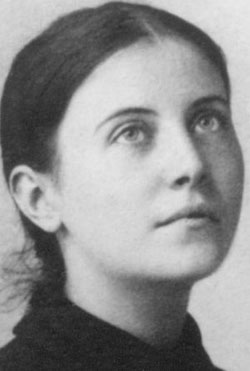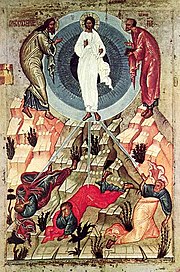
Feastday: April 11
Patron: of Students, Pharmacists, against temptations, against the death of parents, against tuberculosis
Birth: 1878
Death: April 11, 1903
Beatified: May 14, 1933 by Pope Pius XI
Canonized: May 2, 1940 by Pope Pius XII
St. Gemma Galgani, also known as the Flower of Lucca, was an Italian mystic often referred to as the "Daughter of Passion," for her intense replication of the Passion of Christ. She was born on March 12, 1878, in a small Italian town near Lucca.
At a very young age, Gemma developed a love for prayer. She made her First Communion on June 17, 1887. Gemma was loved by her teachers and her fellow students, as a student at a school run by the Sisters of St. Zita. Though quiet and reserved, she always had a smile for everyone. Unfortunately, Gemma had to quit school due to her chronic ill health before completing the course of study.
Throughout her life, Gemma was to be chosen with many mystical experiences and special graces. These were often misunderstood by others, causing ridicule. Gemma suffered heartaches in reparation, remembering that Our Lord Himself had been misunderstood and ridiculed.
Gemma had an immense love for the poor and helped them in any way she could. After her father's death, the 19-year-old Gemma became the mother-figure for her seven brothers and sisters. When some of her siblings became old enough to share the responsibility, Gemma went to live briefly with a married aunt.
At this time, two young men proposed marriage to her. However, Gemma refused because she wanted silence, retirement, and more than ever, she desired to pray and speak only to God.
Gemma returned home and almost immediately became very ill with meningitis. Throughout this illness, her one regret was the trouble she caused her relatives who took care of her. Feeling herself tempted by the devil, Gemma prayed for help to the Venerable Passionist, Gabriel Possenti. Through his intercession, Gemma was miraculously cured.
Gemma wished to become a nun, but her poor health prevented her from being accepted. She offered this disappointment to God as a sacrifice.
Gemma predicted that the Passionists would establish a monastery at Lucca; this came to pass two years after her death. Today, Gemma's relics remain at the Passionist monastery in Lucca.
On June 8, 1899, Gemma had an internal warning that some unusual grace was to be granted to her. She felt pain and blood coming from her hands, feet and heart. These were the marks of the stigmata. Each Thursday evening, Gemma would fall into rapture and the marks would appear.
Such marks, called the stigmata in the language of the Catholic Church, refers to the appearance of the wounds of the crucified Jesus Christ appearing on the bodies of some men and women whose lives are so conformed to His that they reflect those wounds of redemptive love for others.
The stigmata remained until Friday afternoon or Saturday morning. When the bleeding would stop, the wounds would close, and only white marks would remain in place of the deep gashes. Gemma's stigmata would continue to appear until her confessor, Reverend Germanus Ruoppolo, advised her to pray for their disappearance due to her declining health. Through her prayers, the phenomenon ceased, but the white marks remained on her skin until her death.
Through the help of her confessor, Gemma went off to live with another family where she was allowed more freedom for her spiritual life than she was at home. She was frequently found in a state of ecstasy and on one occasion she was believed to have levitated. Her words spoken during her ecstasies, were recorded by her confessor and a relative from her adoptive family.
At the end of her ecstasies, she returned to normal and carried on quietly and serenely. Gemma often saw her guardian angel. She sent her guardian angel on errands, usually to deliver a letter or oral message to her confessor in Rome.
During the apostolic investigations into her life, all witnesses testified that there was no artfulness in Gemma's manner. Most of her severe penances and sacrifices were hidden from most who knew her.
In January of 1903, Gemma was diagnosed with tuberculosis. At the start of Holy Week in 1903, Gemma began suffering greatly. She died at age 25 on Holy Saturday, April 11.. The Parish Priest in her company said, "She died with a smile which remained upon her lips, so that I could not convince myself that she was really dead."
St. Gemma Galgani was beatified on May 14, 1933 by Pope Pius XI and canonized on May 2, 1940, only 37 years after her death, by Pope Pius XII. She is the patron saint against temptations, against the death of parents, against tuberculosis, of students and of pharmacists. Her feast day is celebrated on April 11.
Italian mystic and Catholic saint For other uses, see Gemma (disambiguation).
Maria Gemma Umberta Galgani (12 March 1878 – 11 April 1903) was an Italian mystic, venerated as a saint in the Roman Catholic Church since 1940. She has been called the "Daughter of the Passion" because of her profound imitation of the Passion of Christ. She is especially venerated in the Congregation of the Passion (Passionists).
Early life
| Part of a series on | |||||||||||||||||||||||||||||
| Christian mysticism | |||||||||||||||||||||||||||||
|---|---|---|---|---|---|---|---|---|---|---|---|---|---|---|---|---|---|---|---|---|---|---|---|---|---|---|---|---|---|
 | |||||||||||||||||||||||||||||
Theology · Philosophy
|
|||||||||||||||||||||||||||||
Practices
|
|||||||||||||||||||||||||||||
People (by era or century)
|
|||||||||||||||||||||||||||||
Literature · Media
|
|||||||||||||||||||||||||||||
|
Gemma Umberta Maria Galgani was born on 12 March 1878, in the hamlet of Camigliano in the provincial town of Capannori. Gemma was the fifth of eight children; her father, Enrico Galgani, was a prosperous pharmacist.
Soon after Galgani's birth, the family relocated north from Camigliano to a large new home in the Tuscan city of Lucca in a move which was undertaken to facilitate an improvement in the children's education. Gemma's mother, Aurelia Galgani, contracted tuberculosis. Because of this hardship, Gemma was placed in a private nursery school run by Elena and Ersilia Vallini when she was two-and-a-half years old.
Several members of the Galgani family died during this period. Their firstborn child, Carlo, and Gemma's little sister Giulia died at an early age. On 17 September 1885 Aurelia Galgani died from tuberculosis, which she had suffered from for five years, and Gemma's beloved brother Gino died from the same disease while studying for the priesthood.
Education
Galgani was sent to a Catholic half-boarding school in Lucca run by the Sisters of St. Zita. She excelled in French, arithmetic, and music. At the age of nine, Galgani was allowed to receive her first communion.
Adolescence
At age 16, Galgani developed spinal meningitis, but recovered. She attributed her extraordinary cure to the Sacred Heart of Jesus through the intercession of Gabriel of Our Lady of Sorrows and Marguerite Marie Alacoque.
Shortly after turning 18, Galgani was orphaned, and thereafter she was responsible for the upbringing of her younger siblings, which she did with her aunt Carolina. She declined two marriage proposals and became a housekeeper with the Giannini family.
Mysticism
Further information: Mysticism, Religious ecstasy, and Saints and levitationAccording to a biography written by her spiritual director, Germano Ruoppolo, Galgani began to display signs of the stigmata on 8 June 1899, at the age of twenty-one. She stated that she had spoken with her guardian angel, Jesus, the Virgin Mary, and other saints—especially Gabriel of Our Lady of Sorrows. According to her testimonies, she sometimes received special messages from them about current or future events. With her health in decline, Ruoppolo directed her to pray for the disappearance of her stigmata; she did so and the marks ceased. She said that she resisted the devil's attacks often.
Galgani was frequently found in a state of ecstasy. She has also been reputed to levitate: she claimed that on one occasion, when her arms were around the crucifix in her dining room and she was kissing the wound on the side of the Crucified, she found herself raised from the floor.
Stigmata
Galgani is alleged to have experienced stigmata on 8 June 1899, on the eve of the feast of the Sacred Heart. She writes:
I felt an inward sorrow for my sins, but so intense that I have never felt the like again ... My will made me detest them all, and promise willingly to suffer everything as expiation for them. Then the thoughts crowded thickly within me, and they were thoughts of sorrow, love, fear, hope and comfort.
In the subsequent rapture, Gemma saw her guardian angel in the company of the Blessed Virgin Mary:
The Blessed Virgin Mary opened her mantle and covered me with it. At that very moment, Jesus appeared with his wounds all open; blood was not flowing from them, but flames of fire which in one moment came and touched my hands, feet and heart. I felt I was dying, and should have fallen down but for my Mother (Blessed Virgin Mary) who supported me and kept me under her mantle. Thus I remained for several hours. Then my Mother kissed my forehead, the vision disappeared and I found myself on my knees; but I still had a keen pain in my hands, feet and heart. I got up to get into bed and saw that blood was coming from the places where I had the pain. I covered them as well as I could and then, helped by my guardian angel, got into bed.
Physician Pietro Pfanner who had known Galgani since her childhood examined her claims of stigmata. He observed hysterical behaviour and suspected she may have suffered from a form of neurosis. Pfanner examined Galgani and noted spots of blood on the palms of her hands but when he ordered the blood to be wiped away with a wet towel there was no wound. He concluded the phenomenon was self-inflicted. This was confirmed on another occasion by Galgani's fostermother Cecilia Giannini who observed a sewing needle on the floor next to her.
Psychologist Donovan Rawcliffe has written in a book published nearly 50 years after her death that her stigmata was caused by "self-inflicted wounds of a major hysteric."
Reception
 Gemma Galgani, published in 1916
Gemma Galgani, published in 1916
Galgani was well known in the vicinity of Lucca before her death, especially to those in poverty. Opinions of her were divided. Some people admired her extraordinary virtues and referred to her as The Virgin of Lucca out of pious respect and admiration. Others mocked her (including her younger sister, Angelina, who apparently used to make fun of Galgani during such experiences, and during Galgani's canonization process was deemed as "unfit" to testify due to accusations of attempting to profit from Galgani's reputation).
Death, canonization and devotion
In early 1903, Galgani was diagnosed with tuberculosis, and went into a long and often painful decline accompanied by several mystical phenomena. One of the religious nursing sisters who attended to her stated, "We have cared for a good many sick people, but we have never seen anything like this." At the beginning of Holy Week 1903, her health quickly deteriorated, and by Good Friday she was suffering tremendously, dying in a small room across from the Giannini house on 11 April 1903, Holy Saturday. After a thorough examination of her life by the Church, she was beatified on 14 May 1933 and canonized on 2 May 1940. Galgani's relics are housed at the Sanctuary of Santa Gemma associated with the Passionist monastery in Lucca, Italy. Since 1985, her heart is housed in the Santuario de Santa Gema, in Madrid, Spain. Gemma Galgani's confessor Germano Ruoppolo, who significantly influenced her, wrote a book about her.
The bronze figure on her tomb in Lucca was created by sculptor Francesco Nagni.

